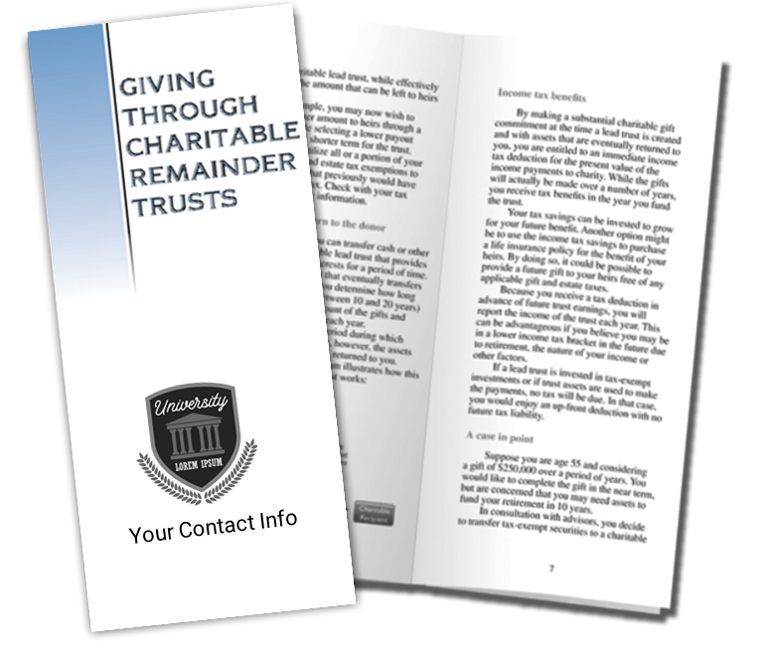 In General Counsel Memorandum AM 2020-006, the IRS responded to a promoter’s request to affirm its legal conclusions that a taxpayer could escape forever capital gains taxation on appreciated property funding a charitable remainder annuity trust (CRAT). The property was to be closely held business interests, farmland and crops. The trust’s terms for the payment of the annuity trust amount and charitable remainder interest were unique. The recipient of the annuity trust would receive the greater of either 10 percent of the initial fair market value of the trust or the payments from a single premium deferred annuity for the five-year duration of the trust. The charitable remainder beneficiaries would immediately receive 10% of the initial fair market value plus $100.*
In General Counsel Memorandum AM 2020-006, the IRS responded to a promoter’s request to affirm its legal conclusions that a taxpayer could escape forever capital gains taxation on appreciated property funding a charitable remainder annuity trust (CRAT). The property was to be closely held business interests, farmland and crops. The trust’s terms for the payment of the annuity trust amount and charitable remainder interest were unique. The recipient of the annuity trust would receive the greater of either 10 percent of the initial fair market value of the trust or the payments from a single premium deferred annuity for the five-year duration of the trust. The charitable remainder beneficiaries would immediately receive 10% of the initial fair market value plus $100.*
The specific guidance sought was three-fold:
- Did the arrangement qualify as a charitable remainder trust?
- Were annuity payments also to be taxed as either ordinary income or a return of principal?
- Was the built-in gain forever exempt from income taxation?
The IRS found two fatal flaws. Firstly the payment to the annuitant was not in a permitted form as it was not a sum certain. Had the CRT been structured as a CRUT, presumably the formula would have passed scrutiny as it then would approximate a net-income-only CRT. Secondly the payment to the charitable remainder beneficiary, while it may be accelerated, must also be made at the termination of the annuitant’s interest.
A single premium immediate annuity (SPIA) creates a stream of payments that are only partially taxable, with each payment consisting of a portion that is a return of original investment and a portion that is income in the hands of a “natural person” as an individual. However, the rules are different if the SPIA is held by a charitable remainder trust. The fact that SPIAs are permissible investments for a CRT does not mean their taxation escapes being governed by the tier accounting rules. In other words, the CRT accumulates capital gain from its sale. Thus, it is very likely the payments to the annuitant are taxable as some combination of ordinary income and capital gain. The annual distributions would be taken from the current and any accumulated ordinary income from the annuity and then the accumulated capital gain from the sale of the funding asset. Only if the capital gain and ordinary income accounts have been zeroed out will there be non-taxable distributions of corpus.
Ordinarily, a CRAT does not pay capital gains tax when it sells the transferred property. The memorandum notes the realized capital gain, while not taxed to the CRT, will be taxed to the recipient of the annuity trust amount according to the tier-accounting rules. The memorandum noted that it is false to say the capital gain would never be taxed to the beneficiary in any amount.
Lessons learned & planning pointers
This ruling effectively grounded the launching of a scheme that would have had very little qualifying charitable intent and thus spared development programs the time and legal expense required to investigate these arrangements.
The IRS has a warning to promoters and, by extension, to charities:
In all cases using this structure, the validity of the CRAT should be challenged both on the basis of disqualifying terms in the instrument and subsequent operational failures, with the result under both theories being (1) the disallowance of any charitable deductions claimed for the value of the remainder and (2) the treatment of the trust as a taxable entity from its creation, causing the sale of any appreciated donated assets to be currently taxable to the trust (or its beneficiaries, if the gain is included in DNI) in the year of sale. In appropriate cases, an assignment of income argument should be made to tax the gain of the sale of assets by the trust to the grantors or to assert SECA tax liability against the trust grantors.
To be forewarned (hopefully) is to be forearmed!
By Professor Chris Woehrle, Chair & Professor of Tax & Estate Planning Department, College for Financial Planning, Centennial, Colorado
Giving Through Charitable Remainder Trusts Booklet
Our Giving Through Charitable Remainder Trusts booklet describes the different benefits of charitable remainder unitrusts and annuity trusts in a clear and understandable manner. The emphasis is on what these trusts can accomplish for your donors, not on simply how they do it. You can add your organization’s logo and contact information to the front and/or back cover of this booklet.
Click here to learn more about ordering imprinted publications.
* See Legal Advice Issued by Associate Chief Counsel for those who seek the details of the reasoning of the Office of Chief Counsel. ↵
Sharpe Group will continue to post helpful information for you here on our blog and on our social media sites. If this blog was shared with you and you wish to sign up, you can do so at www.SHARPEnet.com/blog.
We can be found on Facebook, Twitter and LinkedIn @sharpegroup.
We welcome questions you’d like us to address. Email us at info@SHARPEnet.com and we’ll share your question and our thoughts in this blog and on social media.


